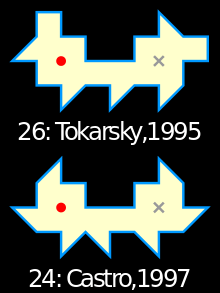Illumination problem

The illumination problem is a resolved mathematical problem first posed by Ernst Straus in the 1950s.[1] Straus asked if a room with mirrored walls can always be illuminated by a single point light source, allowing for repeated reflection of light off the mirrored walls. Alternatively, the question can be stated as asking that if a billiard table can be constructed in any required shape, is there a shape possible such that there is a point where it is impossible to pot the billiard ball in a pocket at another point, assuming the ball is point-like and continues infinitely rather than stopping due to friction.
The problem was first solved in 1958 by Roger Penrose using ellipses to form the penrose unilluminable room.[1] He showed there exists a room with curved walls that must always have dark regions if lit only by a single point source. This problem was also solved for polygonal rooms by George Tokarsky in 1995 for 2 dimensions, which showed there exists an unilluminable polygonal 26-sided room with a "dark spot" which is not illuminated from another point in the room, even allowing for repeated reflections.[2] This was a borderline case, however, since a finite number of dark points (rather than regions) are unilluminable from any given position of the point source. An improved solution was put forward by D. Castro in 1997, with a 24-sided room with the same properties.[1]

References
- 1 2 3 Weisstein, Eric W. "Illumination Problem". Wolfram Research. Retrieved 19 December 2010.
- ↑ Tokarsky, George (December 1995). "Polygonal Rooms Not Illuminable from Every Point". American Mathematical Monthly. University of Alberta, Edmonton, Alberta, Canada: Mathematical Association of America. 102 (10): 867–879. doi:10.2307/2975263. JSTOR 2975263.